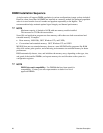28 Boardset Description
SCSI Controller
A QLogic 12160 Ultra 160 SCSI chip provides two 16-bit high-speed SCSI channels. This
high-performance SCSI controller is capable of providing data rates up to 160 MB/sec per channel
in 16-bit operations to ensure maximum data throughput while minimizing PCI bus overhead.
Each channel is capable of operations using either 8- or 16-bit SCSI providing 10 MB/sec
(Fast-10) or 20 MB/sec (Fast-20) throughput, or 20 MB/sec (Ultra), 40 MB/sec (Ultra-wide),
80 MB/sec (40 MHz) (Ultra-2), or 160 MB/sec (40 MHz double clocked) (Ultra 160).
The QLA12160 has its own set of PCI configuration registers and SCSI I/O registers. As a
PCI 2.1 bus master, the controller supports burst data transfers on PCI up to the maximum rate of
132 MB/sec using on-chip buffers.
In the hot-swap SCSI hard drive bay, the system supports up to two 1-inch SCSI hard disk drives.
The 5.25-inch removable media bay supports one SCSI or IDE device (the controller itself
supports more devices, but the 5.25-inch bay can contain a maximum of one device). SCSI
devices do not need to operate at the ultra transfer rate. All drives on the bus must be Ultra 160
(LVD) to run at 160 MB/sec. The 5, 10, and 20 MHz operations can coexist on the bus, and each
device will interact at its appropriate speed.
No logic, termination, or resistor loads are required to connect devices to the SCSI controller other
than termination in the device at the end of the cable. The SCSI bus is terminated on the
I/O carrier with active terminators.
IDE Controller
IDE is a 16-bit interface for intelligent disk drives with AT
†
disk controller electronics onboard.
The PCI/ISA/IDE Accelerator, called PIIX4E, is a multifunction device on the I/O carrier that acts
as a PCI-based Fast IDE controller. The device controls:
• PIO and IDE DMA/bus master operations
• Mode 4 timings
• Transfer rates up to 22 MB/sec (33 MB/sec using ultra DMA transfers)
• Buffering for PCI/IDE burst transfers
• Master/slave IDE mode
Keyboard and Mouse
The PS/2 compatible keyboard and mouse connectors are mounted in a single-stacked housing
with the mouse connector over the keyboard. External to the system, they appear as two
connectors.
The user can plug in the keyboard and mouse to either connector before powering up the system.
BIOS detects these and configures the keyboard controller accordingly.
The keyboard controller is functionally compatible with the 8042A microcontroller. The system
can be locked automatically if no keyboard or mouse activity occurs for a predefined length of
time, if specified through the SSU (see security options in “Security Add-In” on page 57). Once
the inactivity (lockout) timer has expired, the keyboard and mouse do not respond until the
previously stored password is entered.


















